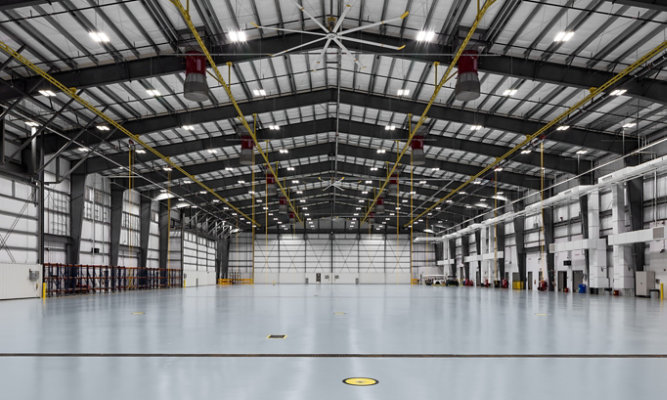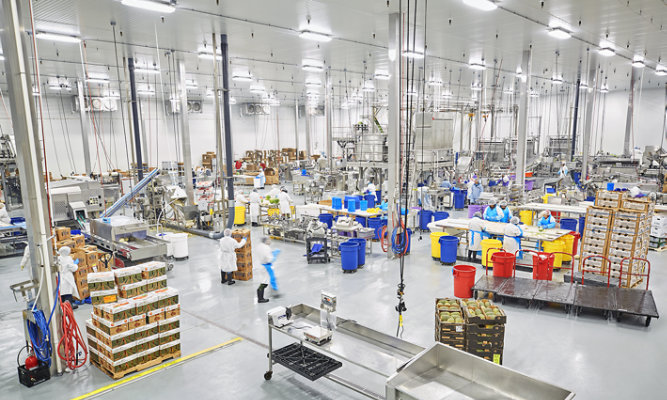Why Moisture Mitigation Systems Are Essential for Clean Room and Dry Room Flooring in EV Battery Manufacturing Facilities
The market for electric vehicle (EV) batteries is growing rapidly. To keep up with demand, new EV battery manufacturing facilities are being built and existing spaces are being transformed to meet the needs of EV battery production. However, this industry is highly regulated, and EV batteries require spaces that are specifically designed to accommodate their manufacturing and production.

One such consideration is in the construction of clean rooms and dry rooms. These spaces depend on flooring systems that can help protect the delicate lithium-ion batteries used in EVs, prevent moisture or moisture vapor from transmitting through the concrete and damaging the batteries. The flooring should also offer outstanding durability and chemical resistance and help extend the lifespan of the EV battery plant concrete floor.
If you are constructing or updating an EV battery manufacturing or production plant, start by considering what type of moisture mitigation system is the best fit for your facility.
The Importance of Moisture Mitigation for Concrete Floors
Concrete is a porous material. When a concrete floor is installed in a space, its porous nature means that water in the form of vapor can migrate through the concrete, starting from below the slab and moving to the air above. This process gets exacerbated as the humidity levels of the room naturally change over time. The concrete moisture tends to travel to pockets of lower humidity and tries to acclimate to the drier, warmer room air.
The added room moisture is undesirable in the highly controlled EV battery plant environment and can be especially detrimental in sensitive EV battery manufacturing dry rooms and clean rooms. The additional moisture or humidity in the air can contaminate these tightly calibrated spaces, resulting in costly operational outcomes.
Many manufacturing and production facilities install high performance floor coating systems comprised of epoxy, polyurethane and other materials to create an impermeable barrier on the plant floor that helps protect and extend the life of concrete slabs. These flooring systems are extremely durable and provide excellent resistance to a wide range of chemicals, wear, impacts, abrasions and slippage, making them an attractive option for any industry.
Despite the substantial benefits they provide, industrial floor coatings can be limited in their ability to withstand extreme alkali attack. When moisture or moisture vapor travels upward through a floor slab, it dissolves some of the salts that are a natural part of concrete. The now highly alkaline moisture/moisture vapor continues to move upward until it hits the underside of the non-permeable floor coating, where the salts then re-crystallize, exposing the coating bond line to high pH attack. As a result, the otherwise impermeable coating can begin to exhibit bubbling, cracking, lifting and debonding from the concrete substrate.
To address these concerns, some manufacturers offer moisture vapor mitigation coating systems for use with their high performance industrial flooring systems. A moisture vapor mitigation coating acts as a barrier against the high alkaline salts that would otherwise attack the industrial flooring from below. At the same time, the barrier coat helps keep the concrete moisture and moisture vapor from entering and potentially contaminating the room environment. These vapor barrier systems are installed directly on the concrete substrate and can be followed by a variety of coatings and topcoats as needed to provide extensive, long-lasting protection.
Moisture Testing Methodologies for Concrete: How to Determine the Level of Vapor Transmission
The best moisture vapor mitigation system for clean room or dry room flooring in EV battery plants depends on the level of vapor transmission in the space. This can be measured using American Standard Test Method (ASTM) F2170-02 or F1869.
These tests must be conducted when the environment of the installation site is at end-use condition. A working level of temperature and humidity is necessary to correctly determine the level of moisture transmission.
ASTM F2170-02: Relative Humidity Test
ASTM F2170-02 measures the relative humidity (RH) of the concrete slab — the amount of moisture available within the slab matrix. Special probes are inserted into the concrete surface for a certain amount of time; the results reveal the level of RH in the concrete during that prescribed period.
In the resinous flooring industry, a result of less than 80% RH is generally accepted as an indication that the concrete can be safely coated.

See EV Battery Facility Flooring Resources
Discover high performance flooring solutions specifically engineered for use in EV battery manufacturing facilities.

Download the EV Battery Plant Facility Coatings Guide
Explore the protective coating solutions curated and engineered for use in EV battery facilities.

Download the EV Battery Manufacturing Facility Protective Coatings Overview Sheet
Learn about the ways our industry-leading expertise and innovative coating solutions can help EV battery facility construction be safer, faster and simpler.
ASTM F1869: Calcium Chloride Test
ASTM F1869 measures the rate at which moisture vapor is moving through the concrete slab. Designated areas of in the concrete floor surface are “opened” using shot blasting or diamond grinding, after which a small, pre-weighed container of calcium chloride desiccant is placed on each opened surface area and sealed with a plastic shell. After 60 to 72 hours, the dishes of calcium chloride desiccant are removed and carefully weighed to determine the rate of moisture vapor transmission.
Most manufacturers require test results of less than 3 pounds per 1,000 square feet in 24 hours before flooring can be installed.
What If Moisture Levels Are Below the Industry Standard Threshold?
If you test your EV battery plant clean room or dry room and find the levels of vapor transmission are below the industry standard threshold, the application of a moisture barrier primer may not be required.
However, these tests are only valid for a snapshot in time. Six months later, conditions could change. Poor drainage under the concrete, broken pipes or environmental conditions can all impact the concrete’s vapor transmission levels. While the concrete may have been below standard levels when the test was conducted, moisture vapor could become a problem later, potentially leading to floor damage and costly production breakdown in sensitive environments.
A moisture vapor mitigation system acts as an insurance policy. To help ensure the clean rooms and dry rooms of your EV battery manufacturing facility have flooring that is designed to mitigate the effects of moisture vapor transmission, apply a moisture vapor mitigating primer or barrier coat.
Mitigating Moisture Vapor Transmission in Clean Room and Dry Room Flooring
Moisture vapor mitigation systems are primers or barrier coats applied directly to the substrate. They act as a barrier between the top of the concrete slab and the lowest layer of the floor coating.
As moisture vapor tries to come up through the concrete slab and move to where the air is drier and warmer, these unique barrier coatings help safeguard the integrity of the floor coating system while simultaneously preventing the slab moisture vapor from entering the EV battery manufacturing environment.
These vapor barrier primers are generally applied after the concrete slab is poured. They are then followed by installation of an epoxy or another type of coating and sealed with a polyurethane topcoat for the full spectrum of protection.
The Problem with Alternative Solutions: What About Below-Slab Vapor Barriers?
An alternative moisture vapor mitigation method is to use a below-slab vapor barrier. As opposed to moisture vapor mitigation coatings and primers, which are applied on top of the concrete slab, below-slab vapor barriers—typically comprised of plastic sheeting—are installed underneath the concrete, before the concrete is poured, to prevent moisture from entering the concrete.
However, once the below-slab vapor barrier is installed and the concrete is poured, it is not uncommon for the vapor barrier is to get compromised due to construction damage/holes, age or environmental conditions.
If the plastic sheet barrier gets damaged, it can further exacerbate the problem by acting like a reservoir. Moisture and moisture vapor from the soil will still try to move upward, finding its way through the breaches in the compromised barrier. Eventually, the vapor can condensate and pool onto the top of the below-slab vapor barrier, giving moisture an unobstructed path to the concrete, floor system and clean room or dry room atmosphere beyond.
How to Choose a Moisture Mitigation System for EV Manufacturing Facilities
At Sherwin-Williams, we offer various moisture mitigation primers to help support the conditions required by EV battery production plant clean rooms and dry rooms. Factors determining which mitigating primer or system is the right fit for a given facility include the results of moisture vapor transmission testing, the age and condition of the concrete slab and the thickness of the floor coating system selected for the space.
Level of Vapor Transmission
The level of concrete moisture vapor transmission can be determined by conducting a professional site analysis and running a moisture test (ASTM F2170-02 or ASTM F1869).
Some moisture vapor mitigation coatings, such as specific cementitious urethane systems in the Sherwin-Williams High Performance Flooring line, do not require moisture vapor testing, as they do not have an upper limit on vapor transmission. For other products, such Sherwin-Williams Resuprime™ moisture vapor barrier coatings, vapor transmission test results determine how thick the barrier coating is to be installed (from as thin as 15 mils for lower RH levels to as thick as 20–25 mils for higher RH levels).
Age and Condition of Concrete
Concrete slabs in existing construction and new construction have different requirements as well. The products you can use and how soon you can coat new concrete after it is poured depend on a variety of factors, including environment, site conditions, concrete mix design, how the concrete was cured and more.
New construction with “green concrete” that is less than 28 days old can be mechanically profiled without falling apart. Thanks to our moisture mitigation primer technology, Sherwin-Williams offers a range of vapor barrier primers that can be successfully installed on green concrete as early as seven days after being poured.
Thickness Category
The required thickness of the moisture mitigation primer depends on the floor coating that will be applied on top of it as well as the expected conditions of the workspace.
For example, in areas with low traffic and low impact, the floor coating system will typically be thinner, so a thinner mitigation primer can also be used. The Resuprime™ line includes thinner moisture vapor mitigation primers that are ideal for these low traffic, low impact areas.
Alternatively, heavy duty areas that are going to be exposed to more traffic, wear and tear, impacts and abrasion require more robust systems. In such cases, moisture vapor mitigation systems must be thicker. The thicker versions of the Sherwin-Williams High Performance Flooring line of cementitious urethane offer excellent solutions.
Contact Sherwin-Williams for Industry-Leading Moisture & Vapor Barrier Systems
Sherwin-Williams moisture vapor barrier systems are specially formulated to meet the rigorous demands of the electric vehicle battery manufacturing industry. When installed in combination with our high performance floor coatings and topcoats, you can achieve outstanding concrete asset protection. The systems help prevent damage from concrete moisture vapor transmission and benefit from excellent chemical and abrasion resistance while also extending the service life of your flooring structure.
Contact a Sherwin-Williams representative today to learn more about our moisture and vapor mitigation options for concrete floors in EV battery manufacturing facilities.
Discover More
Industry Expertise and Innovation
See how we help customers find customized solutions for their project and application challenges.
System Lookup
Find out more about our innovative floor systems for a variety of industries.
FIND A SYSTEM

